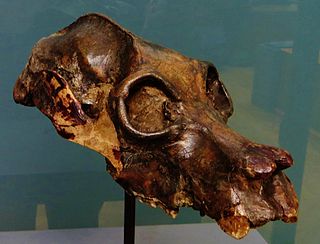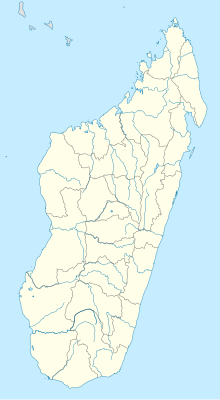
Archaeoindris fontoynontii is an extinct giant lemur and the largest primate known to have evolved on Madagascar, comparable in size to a male gorilla. It belonged to a family of extinct lemurs known as "sloth lemurs" (Palaeopropithecidae) and, because of its extremely large size, it has been compared to the ground sloths that once roamed North and South America. It was most closely related to Palaeopropithecus, the second largest type of sloth lemur. Along with the other sloth lemurs, Archaeoindris was related to the living indri, sifakas, and woolly lemurs, as well as the recently extinct monkey lemurs (Archaeolemuridae). The genus, Archaeoindris, translates to "ancient indri-like lemur", even though it probably became extinct recently, around 350 BCE.

Palaeopropithecus is a recently extinct genus of large sloth lemurs from Madagascar related to living lemur species found there today. Three species are known, Palaeopropithecus ingens, P. maximus, and P. kelyus. Radiocarbon dates indicate that they may have survived until around 1300–1620 CE. Malagasy legends of the tretretretre or tratratratra are thought to refer to P. ingens.

Lemerle's dwarf hippopotamus is an extinct species of Malagasy hippopotamus.

Mullerornis modestus is an extinct species of elephant bird, and the only member of the genus Mullerornis.

Cryptoprocta spelea, also known as the giant fossa, is an extinct species of carnivore from Madagascar in the family Eupleridae which is most closely related to the mongooses and includes all Malagasy carnivorans. It was first described in 1902, and in 1935 was recognized as a separate species from its closest relative, the living fossa. C. spelea was larger than the fossa, but otherwise similar. The two have not always been accepted as distinct species. When and how C. spelea became extinct is unknown; there is some anecdotal evidence, including reports of very large fossas, that there is more than one surviving species.

Several species of Malagasy hippopotamus lived on the island of Madagascar but are now believed to be extinct. The animals were very similar to the extant hippopotamus and pygmy hippopotamus. The fossil record suggests that at least one species of hippopotamus lived until about 1,000 years ago and other evidence suggests that the species may have survived until much more recently. The taxonomy of these animals is not resolved and not widely studied.
William L. Jungers was an American anthropologist, Distinguished Teaching Professor and the Chair of the Department of Anatomical Sciences at State University of New York at Stony Brook on Long Island, New York. He is best known for his work on the biomechanics of bipedal locomotion in hominids such as the 3.4-million-year-old Lucy, and the 6.1- to 5.8-million-year-old Millennium Man Orrorin tugenensis. He devoted much of his career to the study of the lemurs of Madagascar, especially giant extinct subfossil forms such as Megaladapis. More recently, Jungers has been a subject of media attention due to his analysis of the remains of Homo floresiensis, which he believed to be legitimate members of a newly discovered species based on remains of the shoulder, the wrist, and the feet.

The monkey lemurs or baboon lemurs (Archaeolemuridae) are a recently extinct family of lemurs known from skeletal remains from sites on Madagascar dated to 1000 to 3000 years ago.

The sloth lemurs (Palaeopropithecidae) comprise an extinct family of lemurs that includes four genera. The common name can be misleading, as members of Palaeopropithecidae were not closely related to sloths. This clade has been dubbed the ‘‘sloth lemurs’’ because of remarkable postcranial convergences with South American sloths. Despite postcranial similarities, the hands and feet show significant differences. Sloths possess long, curved claws, while sloth lemurs have short, flat nails on their distal phalanges like most primates.

Archaeolemur is an extinct genus of subfossil lemurs known from the Holocene epoch of Madagascar. Archaeolemur is one of the most common and well-known of the extinct giant lemurs as hundreds of its bones have been discovered in fossil deposits across the island. It was larger than any extant lemur, with a body mass of approximately 18.2–26.5 kg (40–58 lb), and is commonly reconstructed as the most frugivorous and terrestrial of the fossil Malagasy primates. Colloquially known as a "monkey lemur," Archaeolemur has often been compared with anthropoids, specifically the cercopithecines, due to various morphological convergences. In fact, it was even misidentified as a monkey when remains were first discovered. Following human arrival to Madagascar just over 2000 years ago, many of the island’s megafauna went extinct, including the giant lemurs. Radiocarbon dating indicates that Archaeolemur survived on Madagascar until at least 1040-1290 AD, outliving most other subfossil lemurs.

Pachylemur is an extinct, giant lemur most closely related to the ruffed lemurs of genus Varecia. Two species are known, Pachylemur insignis and Pachylemur jullyi, although there is some doubt as to whether or not they may actually be the same species. Pachylemur is sometimes referred to as the giant ruffed lemur, because although it and the living ruffed lemurs had similar teeth and skeletons, Pachylemur was more robust and as much as three to four times larger. DNA studies have confirmed a sister group relationship between these two types of lemur. Like living ruffed lemurs, Pachylemur specialized in eating fruit, and was therefore an important seed disperser, possibly for tree species with seeds too large for even ruffed lemurs to swallow. In the spiny thickets of southwestern Madagascar, they were also likely to have dispersed seeds evolved to attach to fur and be carried away. Unlike ruffed lemurs, the fore- and hindlimbs of Pachylemur were nearly the same length, and therefore it was likely to be a slow, deliberate climber. However, both used hindlimb suspension to reach fruit on small branches below them.
Hippopotamus laloumena is an extinct species of hippopotamus from Pleistocene and Holocene Madagascar, making it the oldest of Malagasy hippopotamus. H. laloumena was much larger than other Malagasy hippopotamus, but was still somewhat smaller than the common hippopotamus. However, little is known about the species because it was identified with only a lower jaw and limb bones. It was described in 1990 by French palaeontologists M. Faure and Guerin, the fossils recovered from a site near Mananjary on the east coast of Madagascar. The species name derives from Malagasy laloumena "hippopotamus".

Hadropithecus is a medium-sized, extinct genus of lemur, or strepsirrhine primate, from Madagascar that includes a single species, Hadropithecus stenognathus. Due to its rarity and lack of sufficient skeletal remains, it is one of the least understood of the extinct lemurs. Both it and Archaeolemur are collectively known as "monkey lemurs" or "baboon lemurs" due to body plans and dentition that suggest a terrestrial lifestyle and a diet similar to that of modern baboons. Hadropithecus had extended molars and a short, powerful jaw, suggesting that it was both a grazer and a seed predator.

Babakotia is an extinct genus of medium-sized lemur, or strepsirrhine primate, from Madagascar that contains a single species, Babakotia radofilai. Together with Palaeopropithecus, Archaeoindris, and Mesopropithecus, it forms the family Palaeopropithecidae, commonly known as the sloth lemurs. The name Babakotia comes from the Malagasy name for the indri, babakoto, to which it and all other sloth lemurs are closely related. Due to its mix of morphological traits that show intermediate stages between the slow-moving smaller sloth lemurs and the suspensory large sloth lemurs, it has helped determine the relationship between both groups and the closely related and extinct monkey lemurs.

Mesopropithecus is an extinct genus of small to medium-sized lemur, or strepsirrhine primate, from Madagascar that includes three species, M. dolichobrachion, M. globiceps, and M. pithecoides. Together with Palaeopropithecus, Archaeoindris, and Babakotia, it is part of the sloth lemur family (Palaeopropithecidae). Once thought to be an indriid because its skull is similar to that of living sifakas, a recently discovered postcranial skeleton shows Mesopropithecus had longer forelimbs than hindlimbs—a distinctive trait shared by sloth lemurs but not by indriids. However, as it had the shortest forelimbs of all sloth lemurs, it is thought that Mesopropithecus was more quadrupedal and did not use suspension as much as the other sloth lemurs.

Hypogeomys australis is an extinct rodent from central and southeastern Madagascar. First described in 1903, it is larger than its close relative, the living Hypogeomys antimena, which occurs further west, but otherwise similar. Average length of the femur is 72.1 mm, compared to 63.8 mm in H. antimena. One of the few extinct rodents of Madagascar, it survived to at least around 1536 BP based on radiocarbon dating. Little is known of its ecology, but it may have lived in burrows like its living relative and eaten some arid-adapted plants.

Subfossil lemurs are lemurs from Madagascar that are represented by recent (subfossil) remains dating from nearly 26,000 years ago to approximately 560 years ago. They include both extant and extinct species, although the term more frequently refers to the extinct giant lemurs. The diversity of subfossil lemur communities was greater than that of present-day lemur communities, ranging to as high as 20 or more species per location, compared with 10 to 12 species today. Extinct species are estimated to have ranged in size from slightly over 10 kg (22 lb) to roughly 160 kg (350 lb). Even the subfossil remains of living species are larger and more robust than the skeletal remains of modern specimens. The subfossil sites found around most of the island demonstrate that most giant lemurs had wide distributions and that ranges of living species have contracted significantly since the arrival of humans.

Julian Pender Hume is an English palaeontologist, artist and writer who lives in Wickham, Hampshire. He was born in Ashford, Kent, and grew up in Portsmouth, England.

Hippopotamus madagascariensis, the Madagascar or Madagascan dwarf hippopotamus, is an extinct species of hippopotamus, endemic to the island of Madagascar. Known only from bones, it is believed to have gone extinct sometime after 1500. It was one of three hippopotamus species, the Malagasy hippopotamuses, which were native to Madagascar and are all extinct.
Ampasambazimba is a mountain peak and subfossil site in Madagascar, near Analavory, (Itasy) most known for being the site of the remains of the extinct giant sloth lemur Archaeoindris.















